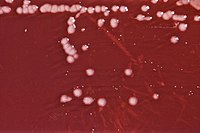
Photo from wikipedia
The biological treatment of textile effluent is enhanced by the use of zinc oxide (ZnO) nanoparticles for the reduction in chemical oxygen demand (COD) from its initial value of 1700 ppm.… Click to show full abstract
The biological treatment of textile effluent is enhanced by the use of zinc oxide (ZnO) nanoparticles for the reduction in chemical oxygen demand (COD) from its initial value of 1700 ppm. The present research investigated the effect of ZnO nanoparticles when microbial cultures of Pseudomonas putida and Pseudomonas aureofaciens were used to treat textile effluent in three-phase inverse fluidized bed bioreactor. The parameters like—size of ZnO nanoparticles, static bed height, superficial gas velocities and solid media particle size—together affected the COD reduction and all of these were investigated in this paper. ZnO nanoparticles of 280 nm reduced the maximum COD to 47 ppm (97.24%) at low gas velocity of 0.0027 m/s at 10% inoculum size and at a static bed height of 2.43 cm.Graphical abstract
Journal Title: Bioprocess and Biosystems Engineering
Year Published: 2018
Link to full text (if available)
Share on Social Media: Sign Up to like & get
recommendations!